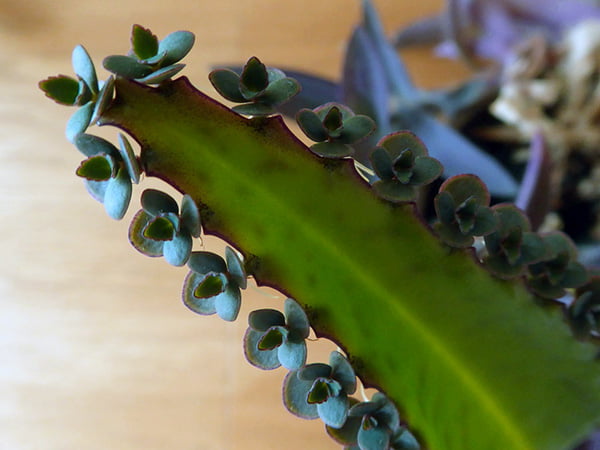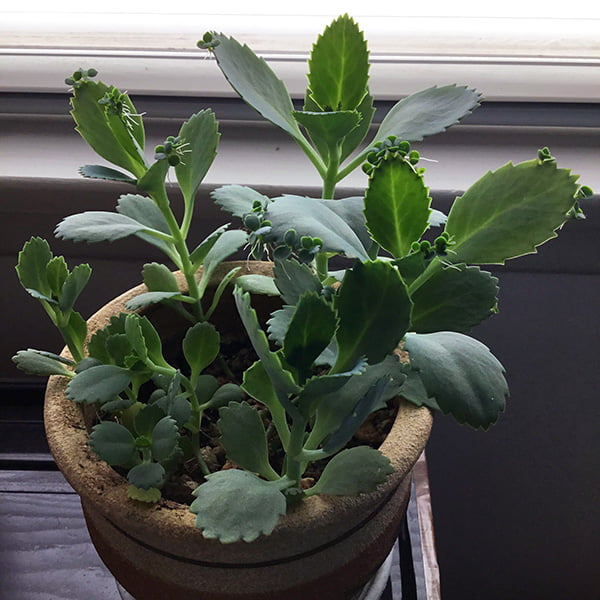The Mother Of Thousands plant (Kalanchoe daigremontiana) is one that often warrants a double-take! Each of the thick leaves sprouts rows of smaller, baby plantlets - and each of those plantlets will readily fall down and take root, quickly filling your pot. Mother Of Thousands is aptly named!
Whether you are new to gardening or have a green thumb, Mother Of Thousand is very easy to care for, and it's great for beginner growers. Below, we'll go through everything you'll need to know to grow this showstopper of a succulent!
Botanical Name
Common Name
Plant Type
Mature Size
Sun Requirement
Soil Type
Hardiness Zone
Pet Friendly
Kalanchoe daigremontiana
Mother of thousands, devil's backbone, alligator plant
Succulent
3 ft. tall
Full sun, partial shade
Well-drained
9 to 11 (USDA)
No
What Is A Mother Of Thousands?
Kalanchoe daigremontiana (Bryophyllum daigremontianum), commonly called Mother Of Thousands, is a succulent plant with a unique growth habit! It's also sometimes called Devil's Backbone, Mexican Hat Plant, and Alligator Plant.
Natively from Madagascar, this plant gets its name from the thousands (literally!) of tiny plantlets that will grow along the edge of each leaf! These baby plantlets will fall off the leaf margins and take root in the potting soil they land on if the soil is fertile. The fleshy, blue-green leaves will reach 8 inches in length, and while the Mother Of Thousands plant can reach 3 feet in height when grown outdoors, it stays small as a houseplant.
Like its cousin, the jade plant, the mother of thousand plants, will produce blooms from time to time if ideal growing conditions are met. They may produce small, grayish lavender flowers in late winter.

Source: flickr
Mother Of Thousands Care Requirements
Light
Mother Of Thousands plants require lots of bright light and can handle direct sunlight if the light isn't particularly strong. An east-facing window is ideal. Even during the summer months, the morning sun will provide enough light without scorching the leaves!
If placed near a west or south-facing window, consider placing the pot back a few feet from the window during the hot summer afternoons, or use a sheer blind to diffuse the sun into softer, indirect light. North-facing windows won't provide adequate light.
You'll know you've got the perfect light location when the leaves are bright green with a red outline along the edge.
Water
Being a succulent species, Mother Of Thousands is very drought tolerant. In fact, it's preferable to underwater them!
In the winter, they only need to be watered once a month. Water your plant every two to three weeks during the spring through fall growing season.
When you do water your Mother Of Thousands plant, however, you'll need to water it thoroughly. Take the pot to a sink and run room temperature water over the soil for a few minutes.
The roots of this plant are very sensitive, so a lukewarm temperature is important! And if the roots receive too much moisture, the plant will suffer. Be sure to use a pot with drainage holes! Let the pot continue to drain for fifteen minutes, then put it back in its home.
Temperature
If your outdoor temperature stays above freezing (USDA zones 9 through 11), then you can grow Mother Of Thousands as an outdoor plant. It's become an invasive plant in some regions, so take care to grow it in a pot or other container, even if growing outside.
For those with cooler temperatures, many gardeners grow Mother of Thousands as house plants. You can even move it outdoors during the summer, bring it in when the weather turns chilly, and get the best of both worlds!
Humidity
Mother Of Thousands is a succulent from subtropical regions, and it does not like overly humid air. If kept indoors, your average room conditions will be perfect.
Soil
The roots of the Mother Of Thousands plant are sensitive - from water temperature, soil moisture, and to air circulation. To accommodate them, use a cactus potting mix. Or, you can make your own cactus soil by mixing coarse sand, perlite, pumice, and vermiculite into regular potting soil.
Planting your Mother Of Thousands in a pot with drainage holes is best. We recommend you can add a layer of pebbles to the bottom of the pot before adding soil.
A terracotta pot is preferred because excess moisture readily evaporates through the porous clay, as the plant doesn't like soggy soil. Choose a small terracotta pot to keep your plant bushier or a larger pot if you'd like a taller one.
Fertilization
Fertilization isn't necessary for a Mother Of Thousands, indoors or out. However, if you'd like, you can feed it with a liquid fertilizer every six to eight weeks during the growing season.
Propagation
Next to no effort is required to propagate Mother Of Thousands plants. If anything, you'll want to actively stop your plant from propagating!
Each of the baby plantlets will drop from the leaf edges of the mother plant and readily take root in the soil it drops onto. Sometimes the leaves will even form roots while attached to the plant. If you have the Mother of Thousands plant near other house plants, you'll likely have baby plants growing in their pots!
If you'd like to propagate new plants purposefully, here is how:
- Pick off a few of the small plantlets and set them directly on moist soil in a new pot.
- Place a plastic bag over the top of the pot to maintain moisture and humidity. Place them in a sunny location, and don't let the soil dry out, but don't oversaturate it either.
- When the plants reach an inch in height, you can remove the plastic bag. If you're going to transplant them from their propagation pot, be sure to give their sensitive roots a wide margin.

Source: flickr
Common Problems With Mother Of Thousands
Going Limp
If you see your plant starting to go limp, it's most likely due to too much moisture. The Mother Of Thousands's leave should be firm and only water when the soil has dried below its surface.
Pests
Some Mother of Thousands can have some pesto issues, including aphids, mealybugs, and scale insects. These pests love Mother Of Thousands as it has thick and juicy leave that they can latch on easily.
Fungal Root Rots
The largest disease potential for this plant is fungal root rot, and this disease can be developed through overwatered soil conditions and can rapidly kill your plant. To avoid this, be sure to use a terra cotta pot and the well-drained potting mix.
Grow Invasively
Mother Of Thousands can spread fast as they self-sow their plantlets easily. To prevent it from spreading rapidly, you will need to stay on top of it, or it can grow invasively.
Yellow Leaves
Yellow leaves can indicate a watering-related issue, and it can be either too much or too little or fertilization issues.
Curled Leaves And Dried Brown Edges
If your Mother Of Thousands' leaves starts to curl and develop dried brown edges, your plant is not getting water and is overly exposed to the sun and scorched.
Is Mother Of Thousands Pet Friendly?
Mother Of Thousands is poisonous in all of its parts. It's been known to cause cattle poisoning in areas where it grows wild and can be fatal to small children and small animals. It is best to keep this one away from your kids and pets.

